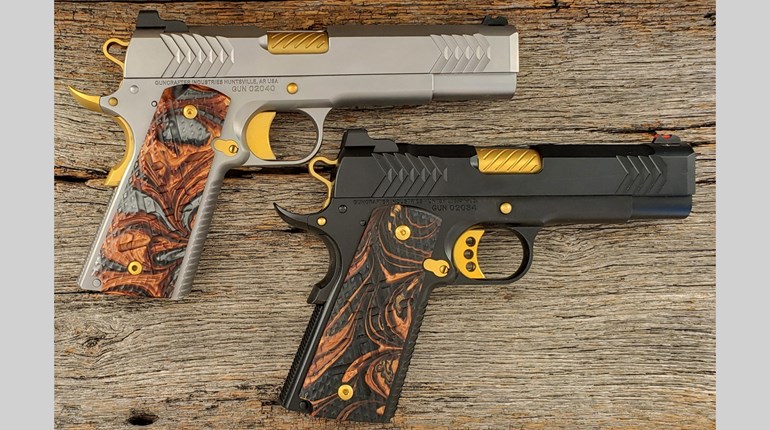
Although 1911-style pistols have numerous qualities that endear them to shooters, price is not one of them. At least not currently, at least not for most of us. As much as I enjoy arguing in favor of the 1911, most of the time I'll yield to the polymer-pistol fan club the minute the discussion turns to dollars, especially in today's trying economic environment.
However, I now have one good reason to no longer concede. It comes in the form of the Citadel M-1911, manufactured in the Philippines by Armscor and imported by Legacy Sports International of Reno, NV. Legacy Sports lists the M-1911 with an MSRP of less than $650, which puts it at—or even below—the price of many polymer-framed semi-autos on the market. More surprising is the M-1911 has features normally reserved for higher-end guns.
Armscor makes the M-1911 with an investment-cast steel frame, and without getting into the cast-versus-forged debate, keep in mind that a host of popular manufacturers of 1911 pistols and their parts go with castings. High-grade ordnance steel and proper heat-treating produce an M-1911 frame that is both durable and economical. As proof, Legacy Sports guarantees the M-1911 to be free of defects in material and workmanship, and will replace or repair free-of-charge any component on the pistol that fails within one year of purchase.

The slide is a 4140 chrome-moly steel extrusion and comes with a lowered and flared ejection port. It mates tightly with the frame of the sample M-1911 sent for testing, thanks to the precise tolerances allowed by Armscor's CNC machines. Six diagonal serrations near the front of the slide provide purchase for your thumb and forefinger when press-checking the status of the chamber. Seven more are located directly above the grip panels. Both sets of serrations are wide and deeply cut and, at least to my eye, they add a bit of aesthetic appeal to this workmanlike pistol.
Parkerizing gives the slide and frame a no-nonsense, matte-black finish. I like the look, but I can't say the same for the various markings on the gun. In a word, horrible. The serial number and model designation on the frame are sloppily misaligned, the Armscor mark on the underside of the dustcover is uneven, and the Citadel logo on the slide isn't parallel with the edges of the part. I can easily forget about the Armscor mark because of its location and even ignore the serial and model numbers, but the logo bugs me. Suffice it to say, the M-1911 is meant to be shot and not displayed.
While I'm griping about looks, the wood grip panels are similarly disappointing. They are checkered in the traditional double-diamond pattern, but the checkering leaves much to be desired. Luckily, grip panels are replaceable, and you'll likely have enough cash left in your wallet after purchasing the M-1911 to get a different set. Or you could go with a M-1911 variant that comes with a Hogue grip for another $50.

In contrast, the checkering on the backstrap and slide-stop lever is deep, even and nicely executed. I'll say the same for the serrations on the ambidextrous safety lever, magazine-release button and skeletonized, elongated hammer. I'd like to see the same checkering applied to the frontstrap instead of it being smooth, but that's a personal preference.
Although I'm not a fan of having a safety lever hanging off both sides of my 1911, I can appreciate the usefulness of the ambidextrous style in dire circumstances. Having said that, the pads on the M-1911's lever are slim to minimize contact on holsters, clothing and other items—my main issue with this type of safety. Despite their streamlined quality, the extended pads are easy to swipe downward with the thumb when the gun is held in a firing grip. No doubt southpaws reading this will be glad to have the ambidextrous lever on the M-1911.
Other semi-custom features include an extended beavertail grip safety with a memory bump, a slightly flared magazine well and a set of low-profile combat sights. The rear sight is rugged, with rounded corners and edges to prevent hang-ups during presentation. In other words, it's appropriate for a pistol intended for personal protection. On the other hand, the front sight is a plain black blade, which works just fine for shooting targets in broad daylight but has obvious shortcomings when the sun sets. Again, though, the money you save on the pistol can go toward a different front sight, which would be easy to replace in the dovetail notch on the slide.

On the range, the M-1911 proved to be well worth its price. Apart from a few failures to feed 200-grain Hornady XTP hollow-point loads during the first five magazines, the pistol functioned reliably. The M-1911 comes with a non-ramped barrel, and even though the owner's manual states the gun is designed to be used with round-nose bullets, it fed about 200 more hollow points with no trouble.
I was pleasantly surprised by the M-1911's accuracy. The overall average for 15, five-shot groups with three loads from Hornady and Winchester was less than 3 inches. That included a couple groups that measured less than 2 inches. I would ask for only slightly better performance from an all-custom 1911 costing five times as much. The M-1911 shoots!
Whether you're a 1911 aficionado looking to add a workhorse shooter to your collection, or a polymer-pistol devotee wanting to branch out, the M-1911 will not disappoint. And that's a point I'll argue all day long.
Manufacturer: Armscor
Importer: Legacy Sports International; (800) 553-4229
Action Type: Recoil-operated, semi-automatic
Caliber: .45 ACP
Capacity: 8+1
Frame: Cast steel with Parkerized finishSlide: Extruded steel with Parkerized finish
Barrel: 5 inches; hammer-forged steel
Rifling: 6 grooves; 1:16-inch RH twist
Sights: Low-profile, combat-style; drift-adjustable for windage
Trigger Pull Weight: 4.88 pounds
Length: 8.56 inches
Height: 5.69 inches
Width: 1.38 inches
Weight: 38.09 ouncesAccessories: Polymer hard case, two Act-Mag magazines, cable lock, owner's manual
MSRP: $649




































